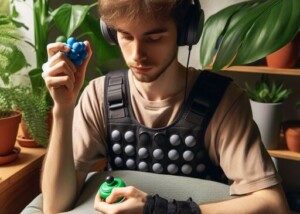
What we call “stimming” — or repetitive movements to feel more at ease or cope with stress — is done by both neurotypical (NT) people and those with Autism Spectrum Disorder.
But it’s the NTs who go about this natural human behavior in a most odd way, yet they think neurodivergent people are the “odd” ones!
Stimming also goes by different names when the neurotypicals do it, such as relaxing, meditating, concentrating, brainstorming or working off some energy.
Neurotypicals need to take a good hard look at their own stimming behaviors before being quick to cast these off as strange or abnormal when someone on the Spectrum does them.
Stimming Drill-Down
ASD Rocking. Usually, this takes place on a regular chair or seat.
The person gently rocks back and forth while engaged in a passive activity such as watching TV, using a computer, reviewing one’s budget, brushing their hair, waiting somewhere, or even eating.
NT Rocking. Neurotypicals do their rocking on objects that rock, usually a rocking chair.
Isn’t that interesting: When someone rocks in a rocking chair, nobody thinks it’s abnormal or neurotic.
But if they rock without the chair, it’s suddenly abnormal or a sign of nervousness. Go figure.
Furthermore, neurotypical adults have been known to gently swing back and forth on a child’s swing set (at least in many TV shows) to gather their thoughts, ease stress or work through some mental muck — and this is considered completely normal, of course.
ASD Oral. An autistic person may repeatedly press or rub their back teeth down on their tongue.
To an observer, it can appear that they’re chewing on food.
Another version is to repeatedly click their teeth together.
NT Oral. Chewing gum. Now gum tastes good, but it doesn’t take long for the sweet taste to wear out.
Yet people will continue chewing a nearly tasteless wad well past its flavor limit.
This has to be stimming. Why else would one continue to chew on a tasteless gummy substance?
Another NT oral is that of clasping an unlit cigar between one’s teeth for extended periods. For what purpose does this serve if it’s not lit?
Sounds like stimming to me. And what about the toothpick off to the side of the mouth? If this isn’t an oral stim, I don’t know what is.
ASD Foot Shake. While a leg is crossed either male or female style, the foot shakes.
NT Foot Shake. The foot starts shaking when the music starts playing.
ASD Leg Swing. A leg swings or sways side to side.
NT Leg Swing. Same thing, except to music.
ASD Hand Flap. Even those with mild autism may find it soothing to “flap” a hand.
But because this particular stim is associated with more severe forms of autism, it’s more likely to be concealed, subdued, or altogether avoided when around other people, especially strangers.
NT Hand Flap. Variations occur while the neurotypical is holding a pen.
They may be flicking a pen (or pencil) any which way while at their desk, and nobody thinks anything of it.
But remove the implement and retain the hand movement, and people will stare and wonder, “Why’s she doing that?”
The character of Olivia Benson in “Law & Order: SVU” has hand stimmed using a pen in several episodes.
I’ve seen many NTs making random movements with pens while on the phone or explaining something.
The pen may get twirled between fingers, shook between fingers, or tapped on a desk or chin.
Another NT version of a hand flap is that of yo-yo-ing. In order to yo-yo, you must flap your hand. NTS have been known to yo-yo while on a conference call or while studying a report, etc. If asked why, they may answer, “It helps relieve stress.”
And yet another NT version of the hand flap is to repeatedly bounce a tennis ball. Yes, the hand must flap to bounce a ball.
One day at the gym I saw three apparent NTs in conversation on the gym floor amid strength training and cardio equipment.
Not too far away was a basketball court. One of the men kept bouncing a basketball straight down as he participated in the conversation. BANG BANG BANG BANG BANG…..
I don’t mean an occasional bounce, but a hard slam to the floor at a quick cadence with both hands — nonstop. It was loud and annoyed me.
This behavior was inappropriate due to its location (gym floor), context (socializing), loudness, and cadence. He wasn’t warming up. He was stimming.
Another variation of a hand flap is when one repeatedly taps an object — such as a small pad of paper, a Stickie notepad, reading glasses, or a checkbook — against the edge of a desk, while engaged in a discussion or concentration. It may also be done during moments of stress or anxiety.
Do you see a pattern here among the neurotypical versions of stimming?
The “normal” people need help with their stimming. They need an inanimate object external to themselves in order to stim.
Though some with ASD also use objects (in fact, objects just for stimming are sold online such as beaded bracelets), this seems to be far more prevalent in NTs.
An autistic child may spin around and around for self-soothing. The NT will sit in the tire hanging from a tree and spin around and around.
Those on the Spectrum usually don’t need help with their stimming.
They can do it all on their own, while NTs need some kind of device or object — often whatever’s available at the moment.
They’ll even stim with an apple: tossing it back and forth between their hands (a form of hand flapping).
People with ASD would like to know why the NTs often need objects to stim with.
Why do they need that toothpick, that pen cap to nibble on, a whole pencil in their mouth to bite down on, stale gum to chew on, and a chair to spin around in? Gee, can’t they just use only a body part?
If you’re self-conscious about hand stimming in public, you may want to consider using an implement.
This way, all the nearby neurotypicals won’t think anything of it.
Accessory-enabled stimming is considered completely normal in an NT-dominated society. Weird.
 Lorra Garrick has been covering medical and fitness topics for many years, having written thousands of articles for print magazines and websites, including as a ghostwriter. She’s also a former ACE-certified personal trainer. In 2022 she received a diagnosis of Level 1 Autism Spectrum Disorder.
Lorra Garrick has been covering medical and fitness topics for many years, having written thousands of articles for print magazines and websites, including as a ghostwriter. She’s also a former ACE-certified personal trainer. In 2022 she received a diagnosis of Level 1 Autism Spectrum Disorder.
.


























